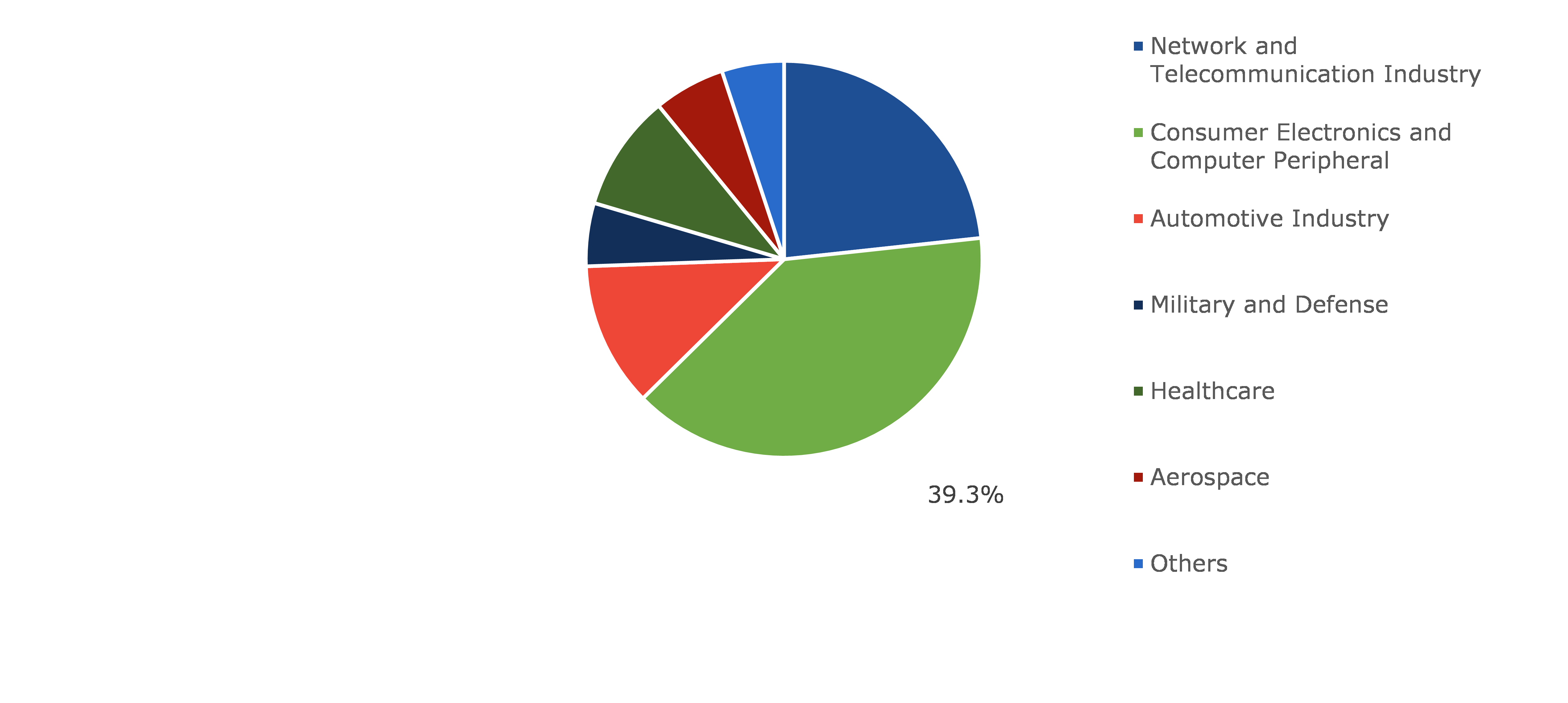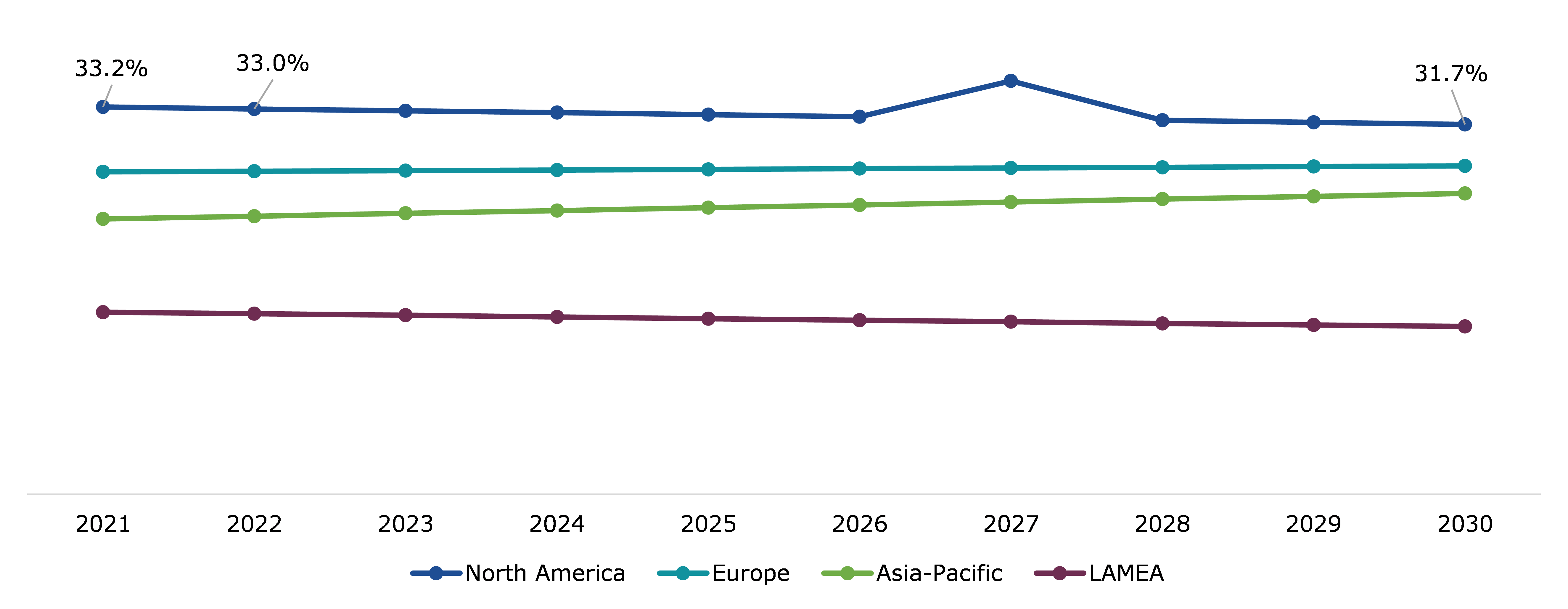Electrostatic Discharge (ESD) Trays Market Report
RA08554
Electrostatic Discharge (ESD) Trays Market by End-user (Network & Telecommunication Industry, Consumer Electronics & Computer Peripheral, Automotive Industry, Military & Defense, Healthcare, Aerospace, and Others) and Regional Outlook (North America, Europe, Asia-Pacific, and LAMEA): Global Opportunity Analysis and Industry Forecast, 2022–2030
Electrostatic Discharge Trays (ESD) Market Analysis
Electrostatic discharge (ESD) trays market accounted for $659.3 million in 2021 is predicted to generate a revenue of $1,312.2 million by 2030, with a CAGR of 8.0% in the forecast period.
Market Synopsis
The ESD trays market is expected to grow due to product advancements and growing demand for the trays in the various end-use industries such as automotive industry. Every year, nearly 6% of electrical products like printed circuit boards and semi-conductors have been broken by static electricity, which is produced by skin friction contacts or contact electrification between two electrically charged items. ESD trays are frequently used as sealed containers in the electrical & electronic industries for these reasons. ESD trays are in short supply in countries such as China, Taiwan, and South Korea to protect devices from external damage. Furthermore, rising per capita income around the world is increasing demand for luxury items such as high-tech vehicles, IoT-enabled home appliances, and the adoption of electric vehicles. All of these factors will be drivers for electrostatic discharge trays in the coming years.
The main impediment, however, is ensuring safety of the electronic components that can get hampered while transportation or due to the electrostatic discharge.
According to the regional analysis of the market, the Asia-Pacific ESD trays market is anticipated to grow at a CAGR of 8.9%, by generating a revenue of $336.7 million during the review period.
Electrostatic Discharge Trays Overview
The electrostatic discharge trays are thick clear plastics which are sturdy and can be easily customized with the required number of compartments that helps in maintaining the proper gaps between the equipment. ESD trays are majorly used for shipping, packaging, and storing of small electronic parts, PCB, circuit boards, and PCBA & electronic components prevent them from getting hampered.
Impact Analysis of COVID-19 on the Global Electrostatic Discharge (ESD) Trays Market
The novel COVID-19 pandemic had a negative impact on the ESD trays market because all manufacturing units worldwide were closed and there was no import or export of raw materials or equipment for which ESD trays are primarily used. Furthermore, pandemic is expected to harm the global electrostatic discharge (ESD) trays market. Due to the government-imposed lockdown during the novel coronavirus outbreak, most consumer electronic industrial sites were shut down.
In addition, labour shortages, raw material supply, and other issues hampered the production of electronic devices. These elements had an immediate impact on the electrostatic discharge (ESD) trays market. As a result of the pandemic forcing certain industries to close, some temporarily and others permanently, the use of electrostatic discharge packaging has decreased dramatically.
However, after the pandemic has passed, the demand for electrostatic discharge (ESD) trays is expected to rise.
Increasing Use of Electrostatic Discharge (ESD) Trays in Multiple End-use Industries is Predicted to be a Major Driving Factor for the Global Market
Electrostatic discharge trays are commonly used in most manufacturing units due to their numerous benefits. Electrostatic discharge trays have excellent antistatic properties that prevent friction from generating antistatic current. Static sensitive products such as PCBs and PCBAs will be protected from electrostatic discharge damage by the trays. Electrostatic discharge trays are designed to provide hermetic protection from external humidity and static electricity flow. For example, leading ESD tray manufacturers are using current metal filler instead of additive, which has reduced production costs and increased the manufacturer's revenue margin. Furthermore, electrostatic discharge trays are widely used to transport and store static sensitive components, which is expected to fuel the market.
To know more about global electrostatic discharge (ESD) trays market drivers, get in touch with our analysts here.
The Handling Process of ESD Trays is Predicted to be a Major Restraint for the Electrostatic Discharge (ESD) Trays Market
ESD trays are difficult to handle as they are very thin and can be broken easily. These trays are expensive, decreasing its affordability in the market. The trays occupy huge spaces and are difficult to handle which can further restrain the growth of the market.
Biodegradable Electrostatic Discharge Tray is Predicted to Create More Growth Opportunities for the Market in the Estimated Period
Increasing investments in recyclable Electrostatic discharge trays by a majority of players in the manufacturing units are predicted to provide better growth opportunities in the forecast period. The biodegradable trays cost less and are light weight.
Moreover, increased internet penetration and e-commerce sales of consumer electronics are driving the growth of electrostatic discharge packaging. The market for ESD trays in this domain is expected to grow significantly over the forecast period, based on this trend. As a result of these factors and developments, electrostatic discharge (ESD) trays are expected to gain traction.
To know more about global electrostatic discharge (ESD) trays market opportunities, get in touch with our analysts here.
Global Electrostatic Discharge (ESD) Trays Market, by End-user
Based on end-user, the electrostatic discharge (ESD) trays market has been segmented into network & telecommunication industry, consumer electronics & computer peripheral, automotive industry, military & defense, healthcare, aerospace, and others of which consumer electronics & computer peripheral sub-segment is expected to have the dominant share during the forecast period.
Global Electrostatic Discharge (ESD) Trays Market Share, By End-user, 2021
Source: Research Dive Analysis
In 2030, the global consumer electronics & computer peripheral sub-segment will be worth more than $533.3 million. Consumer electronics & computer peripheral use the ESD trays in large numbers majorly to maintain proper distance between the electronics components which will help them in not getting tampered in the transportation process. Increasing uses of ESD trays across the industry in consumer electronic and computer peripheral are predicted to drive the sub-segment market in the estimated period. As ESD trays are widely used in the import and export of these products, the market is being driven by the increasing demand for electronic components and instruments related to consumer electronics and computer peripherals. During the forecast period, all of these factors are expected to drive the adoption of consumer electronics and computer peripheral
Global Electrostatic Discharge (ESD) Trays Market, Regional Insights:
The electrostatic discharge (ESD) trays market was inspected across North America, Europe, Asia-Pacific, and LAMEA.
Global Electrostatic Discharge (ESD) Trays Market Size & Forecast, By Region, 2021-2030 (USD Million)
Source: Research Dive Analysis
The Market for Electrostatic Discharge (ESD) Trays in North America to Experience the Dominant Share
North America region market is predicted to have the highest share in the forecast period, growing with a CAGR of 7.5%. The increasing and rapid adoption of new technologies around the world has increased the demand for ESD trays in recent years. The automobile industries are adopting various equipment, which has increased the demand for transportation, leading to the adoption of electrostatic discharge trays to protect them from damage. As a result, demand for electrostatic discharge trays has increased because they maintain proper distance between tools and equipment that are good conductors of electrostatic discharges. The presence of a large number of these material manufacturing units across the region is expected to drive the regional market during the forecast period. All such factors are expected to drive the North America electrostatic discharge (ESD) trays market and witness noticeable growth.
Competitive Scenario in the Global Electrostatic Discharge (ESD) Trays Market
Product launches and mergers & acquisitions are common strategies followed by major market players.
Source: Research Dive Analysis
Some of the leading electrostatic discharge (ESD) trays market players are Smurfit Kappa Group, BASF, Desco Industries, DowDuPont, PPG Industries, TIP Corporation. Conductive Containers Inc., Elcom (UK) Ltd., Tandem Equipment Sales Inc., and Global STATCLEAN SYSTEMS.
| Aspect | Particulars |
| Historical Market Estimations | 2020-2021 |
| Base Year for Market Estimation | 2021 |
| Forecast Timeline for Market Projection | 2022-2030 |
| Geographical Scope | North America, Europe, Asia-Pacific, LAMEA |
| Segmentation by End-user |
|
| Key Companies Profiled |
|
Q1. What is the size of the global electrostatic discharge (ESD) trays market?
A. The size of the global electrostatic discharge (ESD) trays market is expected to be $1,312.2 million in the year 2030, growing from $659.3 million in 2021.
Q2. Which are the major companies in the electrostatic discharge (ESD) trays market?
A. BASF and Conductive Containers Inc. are some of the key players in the global electrostatic discharge (ESD) trays market.
Q3. Which region, among others, possesses greater investment opportunities in the near future?
A. The Asia-Pacific region possesses great investment opportunities for investors to witness the most promising growth in the future.
Q4. What will be the growth rate of the Asia-Pacific electrostatic discharge (ESD) trays market?
A. Asia-Pacific electrostatic discharge (ESD) trays market is anticipated to grow at 8.9% CAGR during the forecast period.
Q5. What are the strategies opted by the leading players in this market?
A. New product development and strategic partnerships are the key strategies opted by the operating companies in this market.
Q6. Which industries are expected to drive the growth of the electrostatic discharge (ESD) trays market in the next 5 years?
A. Automotive industry is expected to drive the growth of the electrostatic discharge (ESD) trays market in the next 5 years.
1.Research Methodology
1.1.Desk research
1.2.Real time insights and validation
1.3.Forecast model
1.4.Assumptions and forecast parameters
1.5.Market size estimation
1.5.1.Top-down approach
1.5.2.Bottom-up approach
2.Report Scope
2.1.Market definition
2.2.Key objectives of the study
2.3.Report overview
2.4.Market segmentation
2.5.Overview of the impact of COVID-19 on Global electrostatic discharge (ESD) trays market
3.Executive Summary
4.Market Overview
4.1.Introduction
4.2.Growth impact forces
4.2.1.Drivers
4.2.2.Restraints
4.2.3.Opportunities
4.3.Market value chain analysis
4.3.1.List of raw material suppliers
4.3.2.List of manufacturers
4.3.3.List of distributors
4.4.Innovation & sustainability matrices
4.4.1.Technology matrix
4.4.2.Regulatory matrix
4.5.Porter’s five forces analysis
4.5.1.Bargaining power of suppliers
4.5.2.Bargaining power of consumers
4.5.3.Threat of substitutes
4.5.4.Threat of new entrants
4.5.5.Competitive rivalry intensity
4.6.PESTLE analysis
4.6.1.Political
4.6.2.Economical
4.6.3.Social
4.6.4.Technological
4.6.5.Environmental
4.7.Impact of COVID-19 on global electrostatic discharge (ESD) trays market
4.7.1.Pre-covid market scenario
4.7.2.Post-covid market scenario
5.Global Electrostatic Discharge (ESD) Trays Market, by End-user
5.1.Overview
5.1.1.Market size and forecast, by end-user
5.2.Network & telecommunication industry
5.2.1.Key market trends, growth factors, and opportunities
5.2.2.Market size and forecast, by region, 2022-2030
5.2.3.Market share analysis, by country 2022 & 2030
5.3.Consumer electronics & computer peripheral
5.3.1.Key market trends, growth factors, and opportunities
5.3.2.Market size and forecast, by region, 2022-2030
5.3.3.Market share analysis, by country 2022 & 2030
5.4.Automotive industry
5.4.1.Key market trends, growth factors, and opportunities
5.4.2.Market size and forecast, by region, 2022-2030
5.4.3.Market share analysis, by country 2022 & 2030
5.5.Military & defense
5.5.1.Key market trends, growth factors, and opportunities
5.5.2.Market size and forecast, by region, 2022-2030
5.5.3.Market share analysis, by country 2022 & 2030
5.6.Healthcare
5.6.1.Key market trends, growth factors, and opportunities
5.6.2.Market size and forecast, by region, 2022-2030
5.6.3.Market share analysis, by country 2022 & 2030
5.7.Aerospace
5.7.1.Key market trends, growth factors, and opportunities
5.7.2.Market size and forecast, by region, 2022-2030
5.7.3.Market share analysis, by country 2022 & 2030
5.8.Others
5.8.1.Key market trends, growth factors, and opportunities
5.8.2.Market size and forecast, by region, 2022-2030
5.8.3.Market share analysis, by country 2022 & 2030
5.9.Research Dive exclusive insights
5.9.1.Market attractiveness
5.9.2.Competition heatmap
6.Global Electrostatic Discharge (ESD) Trays Market, by Region
6.1.North America
6.1.1.U.S.
6.1.1.1.Market size analysis, by end-user
6.1.2.Canada
6.1.2.1.Market size analysis, by end-user
6.1.3.Mexico
6.1.3.1.Market size analysis, by end-user
6.1.4.Research Dive exclusive insights
6.1.4.1.Market attractiveness
6.1.4.2.Competition heatmap
6.2.Europe
6.2.1.Germany
6.2.1.1.Market size analysis, by end-user
6.2.2.UK
6.2.2.1.Market size analysis, by end-user
6.2.3.France
6.2.3.1.Market size analysis, by end-user
6.2.4.Spain
6.2.4.1.Market size analysis, by end-user
6.2.5.Italy
6.2.5.1.Market size analysis, by end-user
6.2.6.Rest of Europe
6.2.6.1.Market size analysis, by end-user
6.2.7.Research Dive exclusive insights
6.2.7.1.Market attractiveness
6.2.7.2.Competition heatmap
6.3.Asia-Pacific
6.3.1.China
6.3.1.1.Market size analysis, by end-user
6.3.2.Japan
6.3.2.1.Market size analysis, by end-user
6.3.3.India
6.3.3.1.Market size analysis, by end-user
6.3.4.Australia
6.3.4.1.Market size analysis, by end-user
6.3.5.South Korea
6.3.5.1.Market size analysis, by end-user
6.3.6.Rest of Asia Pacific
6.3.6.1.Market size analysis, by end-user
6.3.7.Research Dive exclusive insights
6.3.7.1.Market attractiveness
6.3.7.2.Competition heatmap
6.4.LAMEA
6.4.1.Brazil
6.4.1.1.Market size analysis, by end-user
6.4.2.Saudi Arabia
6.4.2.1.Market size analysis, by end-user
6.4.3.UAE
6.4.3.1.Market size analysis, by end-user
6.4.4.South Africa
6.4.4.1.Market size analysis, by end-user
6.4.5.Rest of LAMEA
6.4.5.1.Market size analysis, by end-user
6.4.6.Research Dive exclusive insights
6.4.6.1.Market attractiveness
6.4.6.2.Competition heatmap
7.Competitive Landscape
7.1.Top winning strategies, 2021
7.1.1.By strategy
7.1.2.By year
7.2.Strategic overview
7.3.Market share analysis, 2021
8.Company Profiles
8.1.Smurfit Kappa Group
8.1.1.Overview
8.1.2.Business segments
8.1.3.End-User portfolio
8.1.4.Financial performance
8.1.5.Recent developments
8.1.6.SWOT analysis
8.2.BASF
8.2.1.Overview
8.2.2.Business segments
8.2.3.End-User portfolio
8.2.4.Financial performance
8.2.5.Recent developments
8.2.6.SWOT analysis
8.3.Desco Industries
8.3.1.Overview
8.3.2.Business segments
8.3.3.End-User portfolio
8.3.4.Financial performance
8.3.5.Recent developments
8.3.6.SWOT analysis
8.4.DowDuPont
8.4.1.Overview
8.4.2.Business segments
8.4.3.End-User portfolio
8.4.4.Financial performance
8.4.5.Recent developments
8.4.6.SWOT analysis
8.5.PPG Industries
8.5.1.Overview
8.5.2.Business segments
8.5.3.End-User portfolio
8.5.4.Financial performance
8.5.5.Recent developments
8.5.6.SWOT analysis
8.6.Conductive Containers Inc.
8.6.1.Overview
8.6.2.Business segments
8.6.3.End-User portfolio
8.6.4.Financial performance
8.6.5.Recent developments
8.6.6.SWOT analysis
8.7.Elcom (UK) Ltd.
8.7.1.Overview
8.7.2.Business segments
8.7.3.End-User portfolio
8.7.4.Financial performance
8.7.5.Recent developments
8.7.6.SWOT analysis
8.8.PaySketch
8.8.1.Overview
8.8.2.Business segments
8.8.3.End-User portfolio
8.8.4.Financial performance
8.8.5.Recent developments
8.8.6.SWOT analysis
8.9.Tandem Equipment Sales Inc
8.9.1.Overview
8.9.2.Business segments
8.9.3.End-User portfolio
8.9.4.Financial performance
8.9.5.Recent developments
8.9.6.SWOT analysis
8.10.Global STATCLEAN SYSTEMS
8.10.1.Overview
8.10.2.Business segments
8.10.3.End-User portfolio
8.10.4.Financial performance
8.10.5.Recent developments
8.10.6.SWOT analysis
9.Appendix
9.1.Parent & peer market analysis
9.2.Premium insights from industry experts
9.3.Related reports
Electrostatic discharge (ESD) is a concept that occurs when two electrically charged substances, for instance an electronic device and a human body, come into contact with each other. With technological advancements taking place at an accelerated rate, semiconductor devices are becoming smaller and more sensitive, and thus, the probability of such devices falling prey to any damages due to electrostatic discharge continues to increase. Numerous manufacturing companies consider the damage due to electrostatic discharge as unescapable, ignoring these losses in rework, field service, customer returns, warranty expenses, and eventually charging greater prices to their customers. However, such losses can be foretold, measured, handled in a controlled manner, inhibited, channelled, protected against, and most importantly, averted.
Protective equipment like electrostatic discharge trays are the perfect aid to prevent these losses. Currently, the demand for electrostatic discharge trays is augmenting at a faster rate as the benefits of using these trays are numerous, especially in the manufacturing sectors. Electrostatic discharge trays possess outstanding antistatic properties which can avert the friction that generates antistatic current. These trays help guard static sensitive products like Printed Circuit Board (PCB) and Printed Circuit Board Assembly (PCBA) from damage due to electrostatic discharges. The global electrostatic discharge (ESD) trays market is gaining huge success as these trays are being widely used in packaging, shipping, and storing of small electronic parts, circuit boards, PCBs, and PCBAs & electronic modules to avoid them from getting damaged.
Several companies in the electrostatic discharge tray market are heavily investing in biodegradable electrostatic discharge trays, which is expected to be a boon for the growth of the electrostatic discharge (ESD) trays market. Recyclable trays are affordable and are lightweight, however these trays are currently in their trial phases and need some time to be prevalent in the market.
Recent Trends in the Electrostatic Discharge (ESD) Trays Market
Over the past few years, the global need for electrostatic discharge trays has intensified from the consumer electronics & computer peripheral sector. Moreover, as per a report by Research Dive, the global electrostatic discharge (ESD) trays market is expected to garner $1,312.2 million by 2030, with the North America region holding the dominant market share. Market players are significantly investing in innovative product launches to fulfil the mounting demand for ESD trays.
Some of the leading players of the electrostatic discharge (ESD) trays market are Smurfit Kappa Group, Desco Industries, BASF, DowDuPont, TIP Corporation, PPG Industries, Conductive Containers Inc., Tandem Equipment Sales Inc., Elcom (UK) Ltd., and Global STATCLEAN SYSTEMS. These players are focused on developing strategies such as partnerships, novel developments, mergers and acquisitions, and collaborations to achieve a leading position in the global market. For instance,
- In January 2020, Photocentric, the creator of LCD-based 3D printing, partnered with Mechnano, a 3D printing materials manufacturer, to develop a Nano engineered resin, offering Electrostatic discharge (ESD) properties perfectly suitable for electronics manufacturing. With Photocentric’s 3D printing expertise, the new solution is ideal for the additive manufacturing of components including Part Retrievers, ESD hand tools, Grippers, IC Trays, and others.
- In April 2021, Neocrete Technologies Pvt Ltd., a company manufacturing products for protection, restoration, and renovation of concrete and steel surfaces, introduced an extensive array of specialty ESD products for numerous applications to aid in dealing with the static electricity on several surfaces.
- In January 2022, Smurfit Kappa Group, Europe’s leading corrugated packaging company, announced that it is investing more than $33 million in Brazil to increase the capacity of its plant in Fortaleza to cater the rising demand for innovative and sustainable packaging.
COVID-19 Impact on the Electrostatic Discharge (ESD) Trays Market
The abrupt rise of the coronavirus pandemic has adversely impacted the global electrostatic discharge (ESD) trays market. This is chiefly due to the closure of manufacturing industries worldwide and restrictions on the import or export of the raw materials needed in the development of electronic equipment for which ESD trays are mainly used. However, it is expected that the demand for ESD trays will skyrocket after the relaxation of the pandemic owing to a steep rise in the demand and production of electric and electronic gadgets globally, thus propelling the growth of the global electrostatic discharge (ESD) trays market.
Personalize this research
- Triangulate with your own data
- Request your format and definition
- Get a deeper dive on a specific application, geography, customer or competitor
- + 1-888-961-4454 Toll - Free
- support@researchdive.com





